Weight of 1 meter of galvanized wire, dimensions and weight of a coil of steel wire
The table shows theoretical data. Due to the fact that, according to GOSTs, small deviations (+ or -) in the diameter of the wire are allowed, then the weight of 1 r.m. may also vary slightly.
| f, mm. | Coil weight, kg. | Outer coil, mm. | Inner coil, mm. | 1m / linear kg, not sc. | Weight 1m / rm. kg, gal. | Bay weight, kg. |
| 0,5 | 15 — 20 | 350-400 | 150-200 | 0,0015 | ||
| 0,6 | 20 — 25 | 400 | 200 | 0,0021 | 15-20 | |
| 0,7 | 25 — 30 | 400 | 150-200 | |||
| 0,8 | 30 — 70 | 350-500 | 150-200 | 0,004 | 22-30 | |
| 0,9 | 80 — 100 | 350-500 | 200 | 0,005 | 23-30 | |
| 1,0 | 80 — 130 | 500 | 250-450 | 0,006 | 0,0058 | 57-100 |
| 1,2 | 80 — 130 | 450-800 | 400-450 | 0,009 | 0,0094 | 50-120 |
| 1,25 | 120-160 | 750-800 | 400-450 | 0,0099 | 70-90 | |
| 1,4 | 120-160 | 750-800 | 400-450 | 0,012 | 0,0125 | 150-180 |
| 1,6 | 120-180 | 750-800 | 400-450 | 0,015 | 100-170 | |
| 1,8 | 120-180 | 800 | 400 | 0,019 | 0,0198 | 89-160 |
| 2,0 | 150-180 | 800 | 400 | 0,024 | 0,025 | 100-150 |
| 2,1 | 150-180 | 800 | 400 | 0,028 | ||
| 2,4 | 150-180 | 800 | 400 | 0,0312 | ||
| 2,5 | 150-180 | 800 | 400 | 0,039 | 0,405 | 100-150 |
| 2,8 | 150-180 | 800 | 400 | 0,0447 | ||
| 3,0 | 150-180 | 800 | 400 | 0,055 | 0,0572 | 130-180 |
| 3,25 | 150-180 | 800 | 400 | 0,0574 | ||
| 3,5 | 150-180 | 800 | 400 | 0,075 | 0,078 | |
| 4,0 | 150-180 | 800 | 400 | 0,099 | 0,1029 | 150-200 |
| 4,5 | 150-180 | 800 | 400 | 0,135 | ||
| 5,0 | 150-180 | 800 | 400 | 0,148 | 0,1601 | 150-220 |
| 6,0 | 150-200 | 750-900 | 450-500 | 0,220 | 0,2308 | 160-250 |
| 8,0 | 900-1200 | 1000 | 500 |
Standard values for the mass of galvanized wire:
Grid of weight values of one running meter of OP made of round profile carbon steel, issued in accordance with GOST 1526-81:
0.3 (mm) - 0.003 (kg), 0.5 (mm) - 0.005 (kg), 0.8 (mm) - 0.008 (kg), 1 (mm) - 0.01 (kg), 2 (mm) - 0.02 (kg).
Grid of weight values of one meter of galvanized steel wire of a round profile, produced according to TU 14-4-1457-87:
0.25 (mm) - 0.0025 (kg), 0.3 (mm) - 0.003 (kg), 0.4 (mm) - 0.004 (kg), 0.5 (mm) - 0.005 (kg).
The material should be stored and transported in spools and coils weighing 10 (kg) and 25 (kg), additionally packed in waxed paper, half roll or box.
How thick can it be?
The thickness of the galvanized coating varies. The thicker the coating, the more expensive it will cost and the better its performance will be.
All commercially available diameters:
- OP with a diameter of 2 mm. The thinnest and softest. This material can be easily knitted by hand, but it is not suitable for serious electrical work.
- The 2.2 mm diameter is not much different from the previous version.
- Diameter 3 mm. If this galvanized wire is used, higher strength and durability results can be obtained than if using a wire with a diameter of 2 mm.
- Diameter 4 mm, which has average characteristics in all respects. It is still quite soft, but at the same time it is already very strong and, in terms of its cross section, is quite suitable for use as grounding or for other electrical work.
- Much less common with a 6 mm diameter. It is quite suitable for use in the mesh for finishing work.
- 8mm, the thickest one you can find in a general store. It is ideal for masonry work, concrete floor mesh, etc. But galvanized 8 mm wire rod also costs and weighs much more than its younger counterparts. Therefore, it should be purchased only if you are sure that you need it. In other cases, it will only be a waste of money, because the more millimeters, the more expensive it is.
Any galvanized soft material can be useful to you both in professional activities and in household needs. For home storage and use, galvanized wire rope with a diameter of 1 mm is best suited.
4 Calculation methods for determining the mass of 1 m
It should be noted right away that it is theoretically possible to calculate the mass of barbed wire, of course, but in practice it is extremely difficult. And even if you cite the calculation methodology, it is unlikely that any of the visitors to this site will decide to use it. Therefore, below are calculation methods only for products of the correct circular cross-section without any additional elements on it (like spikes and others).
 When calculating the weight of the wire, an adjustment is made for its density
When calculating the weight of the wire, an adjustment is made for its density
The mass of 1 m of any such "ordinary" wire can be calculated using the following formula: m = P * D * D * G / 4, where
- m - theoretical (calculated) weight of 1 meter, kg;
- P is a constant (constant value) equal to 3.14;
- D - it is already clear that the diameter of the wire, m, needs to be measured;
- G is the density of the metal of the wire: usually, in the calculations, it is taken for steel - 7850 kg / m3, copper - 8890 kg / m3, aluminum - 2703 kg / m3.
For more accurate calculations, find out the grade of the alloy. Then they learn from GOSTs or reference books its density, which may differ from the above values. And only then do the calculations.In addition, for products made of aluminum and copper alloys, you can make a calculation using data on the mass of 1 m of steel wire (including those indicated in the table above). To do this, use the following formula: M = MC / QC * Q, where
- M - weight of 1 m of copper or aluminum wire, kg;
- MS - weight of 1 m steel, kg;
- Q is the density of copper or aluminum: 8890 and 2703 kg / m3, respectively;
- QC - density of steel: as indicated above, 7850 kg / m3.
And one more way of calculating
When the mass of 1 m of a product of any diameter is known, and it does not matter from what metal, then you can always calculate this characteristic for a wire with a different thickness and from a different alloy. The easiest way to do this is if the material of the product with a known weight and the calculated wire is identical (both products are made of steel, copper or aluminum)
Then it is enough to use the formula: MP = mп / K, where
- MP is the estimated weight of 1 m of a product of the required diameter made of any metal, kg;
- mп - known mass of 1 m of wire of any diameter from the same alloy, kg;
- K is the coefficient that is calculated: K = k * k, where k = DI / DH (DI is the diameter of a wire with a known mass of 1 m, DH is the thickness of the product for which the weight of 1 m is calculated).
Production
Globally galvanized wire can have as its core not only steel, but also aluminum, copper or even titanium strings. We consider steel in this article with the maximum increase simply because it is relatively inexpensive, and at the same time, it is able to satisfy the needs of most consumers. Specific galvanized wire based on strings from other metals is mainly produced to order for industrial enterprises. If many companies are engaged in galvanizing steel cord, then galvanizing of copper, titanium and aluminum is offered much less often.
It is important to note that zinc coating, like no other, provides the metal core with the longest possible service life and impressive strength. Neither external painting nor a protective polymer layer on top of the metal can provide the same effect as galvanized
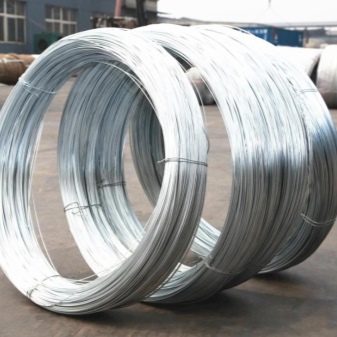
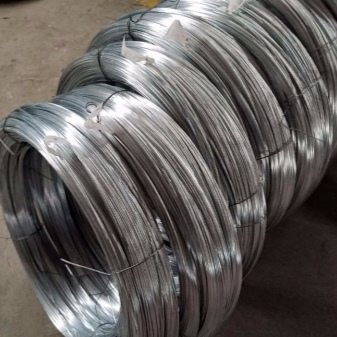
Today, most often resorted to galvanized strings or hot galvanized. Alternatively, cold, thermal gas or thermal diffusion methods of applying a zinc layer can be used. Rarer methods of galvanizing may be in demand if the wire is needed to solve specific problems; there is usually no widely available products manufactured by such methods.
In the modern world, the production of galvanized wire is established in all more or less large countries of the world - it is such a hot commodity that it would be foolish to depend on supplies from abroad. When choosing a wire for your own needs, you should focus not so much on the country of manufacture, but on the specific characteristics of a particular sample of goods, comparing them with those properties that are needed to solve your problem.
Overview of species by galvanizing method
Soft steel wire is coated with a thin layer of zinc to improve its performance, but there are two most common ways to do this. Some masters say that the buyer does not need to know exactly how the galvanizing was done, especially since the manufacturers themselves usually do not indicate this. However, the second method, hot, implies higher production costs, and therefore the cost of the final product will be slightly higher.
Electroplating
Galvanization of the wire to cover it with a zinc layer is carried out in a special bath. The steel cord is immersed in a thick solution of zinc-based salts, however, the process will not go naturally - human intervention is necessary. For this, an electric current is passed through the container. In this case, a special electrode serves as the anode, and the wire itself is the cathode.
Under the influence of electricity, the salts decompose, the liberated zinc is deposited on the steel cord. After completion of the procedure, when the zinc layer becomes sufficient to adequately protect the core, the current is turned off and the finished galvanized wire is removed. The great advantage of this method is that under the action of electricity, steel and zinc are, as it were, soldered together at the molecular level. In this case, delamination of the outer zinc layer is simply impossible, since at the lower levels it is literally integrated into the thickness of the steel.
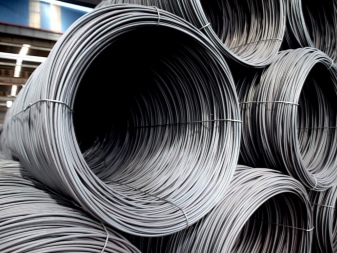
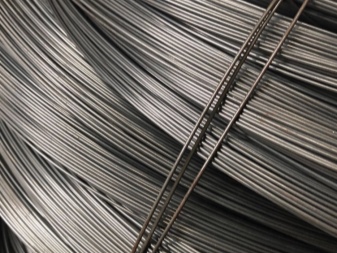
Hot
With hot galvanizing, the procedure looks somewhat different - the steel core is also immersed in a liquid, but now it is no longer a salt solution, but a molten mass, which includes zinc and some other chemical elements. This method is somewhat more expensive for the manufacturer than galvanizing, but is considered potentially more reliable, because zinc covers the steel more densely, with a slightly thicker layer. In this case, the coating does not always lay down evenly along the entire length of the cord.
Another thing is that the described production method requires careful adherence to the technology, since a violation of the temperature regime can significantly reduce the strength indicators of the finished wire rod.
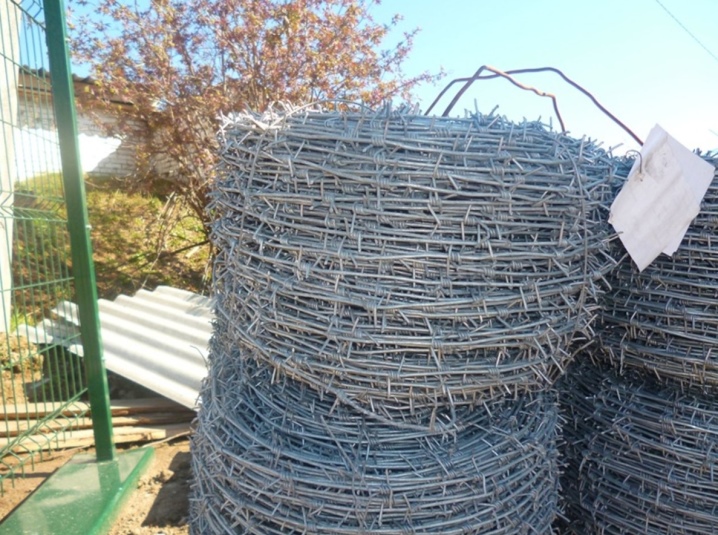
You can check how conscientiously the manufacturer treated the task right in the store when choosing products
To do this, try bending and unbending a piece of wire, pay attention to the resulting bend


2 Weight of 1 m of any wire - methods and nuances of determination
Most often, it is still necessary to determine the weight of 1 m, since manufacturers, and then suppliers of wire, ship it in meters (indicating the length of individual coils or coils and the total footage) or in kilograms and even tons. In the latter case, as a rule, the total weight of the entire delivered batch is indicated. And then, in the first delivery option, it is necessary to find out the total weight of the wire received, and in the second - the total length (of a batch or coils and coils after weighing them). And this can be done using the above formulas, only by first determining the mass of 1 m.
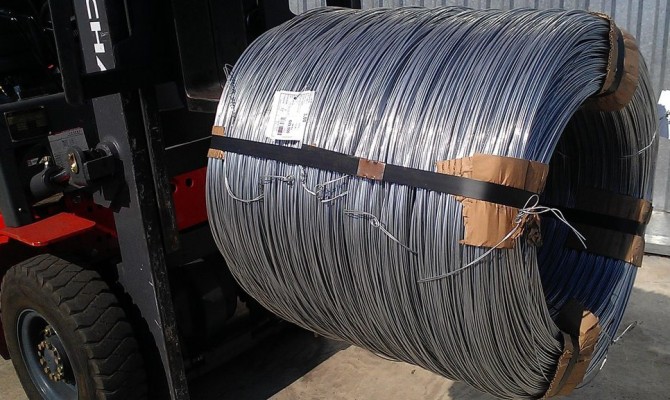 The easiest way to find out the weight of the wire is by weighing
The easiest way to find out the weight of the wire is by weighing
The most accurate and reliable way to determine the weight of 1 m of wire is to weigh a piece of this length. And the simplest, but far from always effective, is to look at the tables of the produced standard sizes (diameters) of the corresponding GOST or reference manual. And the third way is to calculate it yourself according to the measured diameter. This option is inferior to the first in accuracy, but it may be preferable to the second, and in terms of speed of execution it most often surpasses these both, but only if we are talking about ordinary wire (just a circular cross section), and not barbed.
The specified characteristics for the listed methods follow from the nuances that can be encountered by choosing one or another way of determining the mass of 1 m of wire. As for the first method: it is not always possible to weigh, or it is associated with certain difficulties and takes a lot of time. Regarding the second, the following should be noted. It is not always possible to have the necessary GOST, reference book or the opportunity to find them on the Internet at hand. And even if the necessary document is found, then not everyone will have the required information - the weight is 1 m. The fact is that not all GOSTs (not for all types of wire) indicate this characteristic.
And the last point about the second method - in the standards and reference books, if the mass of 1 m is given, then the theoretical one. That is, calculated by the nominal diameter of this product and some average value of the density of the metal from which it is made (for steel products - 7850 kg / m3, copper - 8890 kg / m3, and aluminum - 2703 kg / m3). And the actual thickness may differ from the nominal one regulated by GOST within the tolerances established by the same standard. And the alloy from which the wire can have a density that differs from that used in the calculations.This means that the actual mass of 1 m will differ from the tabular one.
To implement the third (calculated) method, it is enough just to know or measure the diameter of the wire. Well, and, of course, you need to know what metal it is made of (steel, copper or aluminum). Then, using this data, you can resort to using a calculator (on the Internet) for the weight of the wire. Or calculate the mass of 1 m yourself using certain formulas. How to do this will be described below. It is easy to guess that the calculation method will also not give the exact actual weight. In this regard, it has the same flaws as when determining this characteristic according to GOST. That is, the diameter along the entire length of the product "walks", and the density of the metal may differ from that used in the calculations.
But due to this disadvantage of the calculation method, you can safely ignore any coatings on the wire (zinc, polymer, enamel) in the calculations. After all, their thickness in comparison with the diameter of the calculated product will always be negligible. And therefore, the above error will "absorb" the one that was caused by the neglect of the coating. That is, it is still unknown which calculation will turn out to be more accurate (closer in value to the actual weight of 1 m), since the maximum tolerances for deviations from the nominal wire diameter are much greater than the thickness of any coating, which, by the way, also varies in magnitude in a certain specific range, according to the corresponding GOST. And besides, the density of most coatings is less than that of wire metal.
And one more point, which for the majority of those dealing with this rolled metal testifies "against" taking into account the mass of the coating when calculating its weight. Determining the thickness of a thin coating is a very complex and even laborious process. And the subsequent separate calculation of the mass of the coating and the core of the product also significantly complicates the calculations, while again giving only approximate results for the weight of 1 m, and subsequently the coil (roll) and the batch. Therefore, for all products (including galvanized, coated with enamel, polymer) it makes sense to use one calculation method - used for uncoated products.
Scope of flexible material
It is very difficult to list the scope of such a product. In production, galvanized steel wire is used to manufacture:
- Grids.
- Trosov.
- Springs.
- Electrical wires.
- Electrodes.
The most widespread is the round section. In everyday life, other sections are also used:
- Square.
- Oval.
- Hexagonal.
It is very rare to find a 4 mm galvanized product with a trapezoidal section.
Wire manufacturing technology
Zinc coating of such products is performed in several ways. They have characteristic differences.
- Electroplated coating. When performing such work, a saline solution is used, coupled with an electric current. The product will act as a cathode. Any external electrode becomes the anode.
- Hot method. The material is dipped into a molten zinc solution with other chemicals. If all the requirements of the technological process are followed, the zinc coating becomes maximum. If the temperature regime is violated, the product may lose its strength.
When purchasing a product from a specialist store, you can check its condition. It is enough just to bend the wire rod and then sharply unbend it. A characteristic trace will remain on the metal surface. If it is clearly seen that the wire will soon break, therefore, its strength characteristics have decreased. This material won't last very long. It will break quickly.
Positive characteristics of wire rod
Galvanized material has gained great popularity due to its excellent properties. They are far superior to other products that do not have a special coating. The advantages of galvanized wire include:
Thanks to zinc, any influence of the atmosphere is reflected.In other words, the product remains neutral to high humidity and atmospheric conditions. Under such conditions, ordinary wire will quickly rust and crumble. Galvanized wire rod is designed for a long service life.
The appearance of the product looks nice and very modern.
Small nails are made from such galvanized wire, which has undergone a good heat treatment. The most popular are the diameters of 3-8 mm. Very good nails are obtained from this section.
Zinc coated wire rod is used to create armored wiring when laying various types of cable.
Optimum coating thickness
In the manufacture of wire rod, zinc coating is made of different thicknesses. The performance characteristics as well as the cost of the product depend on the thickness of the coating. The thicker, the more expensive. Professionals recommend using the average.
In construction, such wire is used to reinforce concrete, perform plastering work, and create brickwork.
Wire rod with a diameter of 2 mm is considered the thinnest. Thanks to its softness, it is easy to work with your hands. It is used in electrical engineering. So, 3 mm galvanized is highly durable. It is designed for long-term operation.
Much less often you can find a wire with a cross section of 6 mm. It is used to make mesh when finishing work is done. And 8 mm galvanized wire rod is used to create a concrete floor, for reinforcement, when laying walls and performing a variety of construction work.
Related Posts via Categories
- Semi-automatic welding wire - choosing the right working tool
- Welding wire stainless steel - for corrosion-resistant seams
- How to choose and how much knitting wire should be taken for tying fittings?
- Application of flux-cored wire for semiautomatic device
- What features does galvanized wire have and what are its varieties?
- Galvanized steel wire as a semi-finished product for the manufacture of products
- Spring wire - what standards is it made to?
- Steel wire - finished product and material for various designs
- Sv-08G2S - wire for high-quality surfacing and welding
- Welding wire - a reliable connection of metals
Low-carbon steel wire for general use
Technical characteristics for low-carbon steel wire for general use in accordance with GOST 3282-74
Low-carbon steel wire for general purpose complies with GOST 3282-74. The OK wire is supplied thermally treated (t / o) and thermally untreated (t / n) of normal and high accuracy. OK wire is used for the manufacture of metal mesh, construction nails, for tying bundles of pipes, boards and other packaged materials during transportation, loading and storage, as well as for fencing and other purposes. OK wire is supplied in coils and coils weighing up to 1.0 t.
1. Raw material for the manufacture of wire is wire rod made of carbon steel of ordinary quality according to DSTU 2770-94 (GOST 30136-95). The wire is produced thermally untreated, uncoated, cold, of normal accuracy.
| steel grade | Carbon C | Silicon Si | Manganese Mp | Sulfur S | Phosphorus P | Chrome Gr | Nickel Ni |
|---|---|---|---|---|---|---|---|
| No more | No more | ||||||
| SV08 | 0.10 | 0.03 | 0.35-0.60 | 0.04 | 0.04 | 0.15 | 0.30 |
| SV08A | 0.10 | 0.03 | 0.35-0.60 | 0.03 | 0.03 | 0.12 | 0.25 |
| Art.1kp | 0.06-0.12 | 0.05 | 0.25-0.50 | 0.045 | 0.055 | — | — |
2. Wire diameter and dimensional tolerances:
| Wire diameter, mm | Limit deviations in diameter, mm |
|---|---|
| 0,8-1,01,1-1,21,3-2,02,0-3,03,5-4,54,5-6,0 | -0,05-0,06-0,1-0,12-0,16-0,16 |
2.2 The mechanical properties of the wire must correspond to those indicated in the table. At the request of the consumer, heat-treated wire is manufactured with a regulated relative elongation.
| Wire diameter, mm | Ultimate tensile strength, N / mm2 | Relative extension, %. not less, for heat-treated wire | ||||
|---|---|---|---|---|---|---|
| thermally untreated | thermally treated | |||||
| I group | II group | without cover | coated | without cover | coated | |
| from 0.16 to 0.45 incl. | 690-1370(70-140) | 690-1370(70-140) | 290-490(30-50) | 340-540(35-55) | 15 | 12 |
| sv 0.45 >> 1.00 >> | 690-1270(70-130) | 690-1180(70-120) | ||||
| >>1,00 >> 1,20 >> | 590-1270(60-130) | 690-1180(70-120) | ||||
| >>1,20 >> 2,50 >> | 590-1180(60-120) | 690-980(70-100) | ||||
| >>2,50 >> 3,20 >> | 540-1080(55-110) | 640-930(65-95) | 20 | 18 | ||
| >>3,20 >> 3,60 >> | 440-930(45-95) | |||||
| >>3,60 >> 4,50 >> | 590-880(60-90) | |||||
| >>4,50 >> 6,00 >> | 390-830(40-85) | 490-780(50-80) | ||||
| >>6,00 >> 7,50 >> | — | |||||
| 8,00 | 390-780(40-80) | |||||
| from 8.00 to 10.00 | 440-690(45-70) |
GOST 3282-74 Low-carbon steel wire for general purpose
Rice. Cross section of wire
In this table, the following designations are adopted: d - wire diameter; • the sign means that the given wire diameter is provided for by GOST 3282-74
| Nominal wire diameter, d, mm | Weight 1000 m, kg | GOST | Nominal wire diameter, d, mm | Weight 1000 m, kg | GOST | |
|---|---|---|---|---|---|---|
| 0,8 | 3,9458 | • | 3 | 55,488 | • | |
| 1 | 6,1654 | • | 3,2 | 63,133 | • | |
| 1,1 | 7,4601 | • | 3,5 | 75,526 | • | |
| 1,2 | 8,8781 | • | 3,6 | 79,903 | • | |
| 1,3 | 10,419 | • | 4 | 98,646 | • | |
| 1,4 | 12,084 | • | 4,5 | 124,85 | • | |
| 1,6 | 15,783 | • | 5 | 154,13 | • | |
| 1,8 | 19,976 | 5,5 | 186,50 | • | ||
| 2 | 24,662 | • | 5,6 | 193,35 | • | |
| 2,2 | 29,840 | • | 6 | 221,95 | • | |
| 2,5 | 38,534 | • | 6,3 | 244,70 | • | |
| 2,8 | 48,337 | • | 7 | 302,10 | • |
Note: The theoretical weight of 1000 m of wire is calculated from nominal dimensions with a steel density of 7850 kg / m and is a reference value.
Diameters
As mentioned above, this parameter directly affects potential applications. Without prior experience with such wire products, the buyer can make a mistake when choosing the material, so let's briefly go through all the most common thickness standards.
- 2 mm. In most cases, thinner galvanized wire is simply not made, and due to its modest diameter, it is distinguished by increased softness. The latter factor allows you to knit such a cable with your bare hands, but in electrical engineering it is practically useless. There is also a 2.2 mm standard - it is slightly stronger, but the difference is almost imperceptible when working with it.
- 3 mm. In general, this is the same previous version, allowing easy manual handling due to the comparative softness of the cable. At the same time, it is taken by those who need a certain margin of durability and strength.
- 4 mm. This diameter is considered to be average in all parameters. You can still knit it with your own hands, but the rigidity is already felt. Due to the increased safety margin, products of this type are suitable for electrical work - for example, grounding can already be made from this wire. In addition, galvanized wire rod of this thickness is often used in products such as homemade bucket handles. There is also a slightly thicker version of 5 mm, but it is very rare and not very convenient to work with.
- 6 mm. This standard is relatively rare, and the reason for this is quite obvious - it is used mainly to create reinforcing meshes before installing the finish. There are practically no other use cases.
- 8 mm. In most cases, this is the thickest variety of such a product - 10 mm, if found somewhere, then only to order. In terms of strength, it is an unambiguous leader, the material is suitable for reinforcing the future flooded floor or brickwork. At the same time, he does not really have any other options for using it, which means that you need to purchase it only when you understand why.
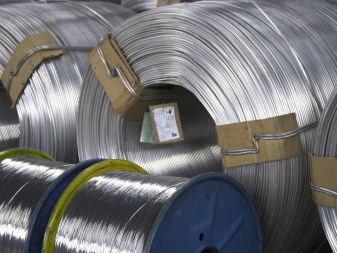


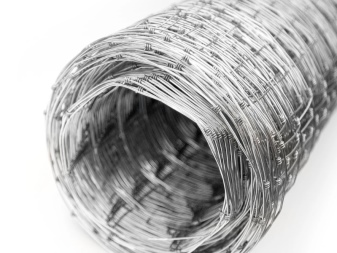
The following video shows the production of galvanized wire.
3 Tabular masses - from GOSTs and other sources
Still, steel wire is in great demand for construction, industrial production, general economic and other needs. Therefore, for it below, the masses of 1 m of the most common diameters are given
Moreover, these data are taken from GOSTs, and it does not matter what type of product it is (knitting wire, wire rod or some other), but the weight of steel products of the same diameter will be the same.
|
Steel wire |
Nominal diameter, mm |
||||||||||
|
2 |
3 |
4 |
5 |
5,5 |
6 |
6,3 |
6,5 |
7 |
8 |
9 |
|
|
Weight 1 m, kg |
0,025 |
0,055 |
0,099 |
0,154 |
0,187 |
0,222 |
0,245 |
0,260 |
0,302 |
0,395 |
0,499 |
For copper and aluminum wires in GOSTs, the mass of 1 m is not indicated on them. But how to calculate it will be discussed in the next chapter.
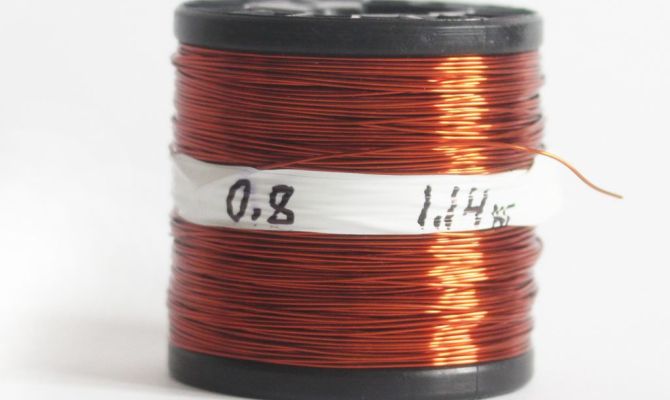 The tabular weight of the wire is taken from GOSTs
The tabular weight of the wire is taken from GOSTs
For barbed wire, there is no data on its mass of 1 m in the standards for it either. But a number of Internet sites provide the following information about this characteristic. For uniaxial (with one wire at the base) "thorns":
|
Specifications |
Uniaxial Barbed Wire Type |
||
|
Galvanized КЦ-1 with a base wire with a diameter of 2.8 mm, produced in accordance with GOST 285-69 |
Type AKL (types: Gyurza, Kazachka, Egoza, Forget-me-not) |
ASKL type (types: Gyurza, Kazachka, Egoza, Forget-me-not) |
|
|
Weight 1 m, kg |
0,088 |
0,95 |
0,95 |
|
Linear meters in the bay |
400–450 |
100 |
100 |
|
Coil weight, kg |
35,2–39,6 |
9,5 |
9,5 |
For a biaxial galvanized "thorn" (based on a twist of 2 wires), produced according to TU U 27.1-136-001-2002:
1 What weight of wire is of interest?
Any wire is supplied in coils or skeins. And someone needs to know their weight. Say, if you need to transport a certain number of bays with a known required footage. Indeed, the choice of the type and carrying capacity of the vehicle for delivering the wire to the destination will depend on their total mass.
And for someone it is important to know the mass of 1 m of this type of metal products. For example, to designers, in order to take into account the weight of the wire in the total mass of structures or products they design
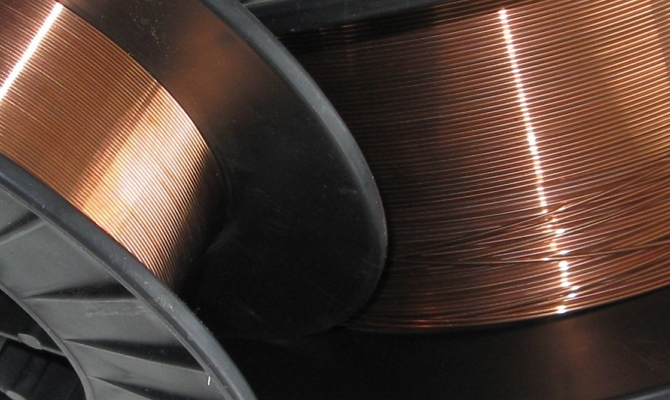 Any wire is supplied in coils or skeins
Any wire is supplied in coils or skeins
And also, by the same to the carriers of this metal products, in order to recalculate the quantity of meters shipped known to them into kilograms or tons. Obviously, it is enough to know 2 of the above 3 characteristics of the wire in order to calculate the one that is unknown and needed. For example, if there is data on the mass of 1 m of wire and the total footage of one or all coils, then their total weight can be calculated. And if you know the last parameter and the total footage or mass of 1 m, then you can calculate the weight of 1 meter or the total length, respectively.
All these calculations fit into the formula: M = L * m, where
- L is the total length of the wire (for example, in a coil or in a whole batch), m;
- M is the total mass of a wire of length L, kg;
- m - mass of 1 m, kg.
